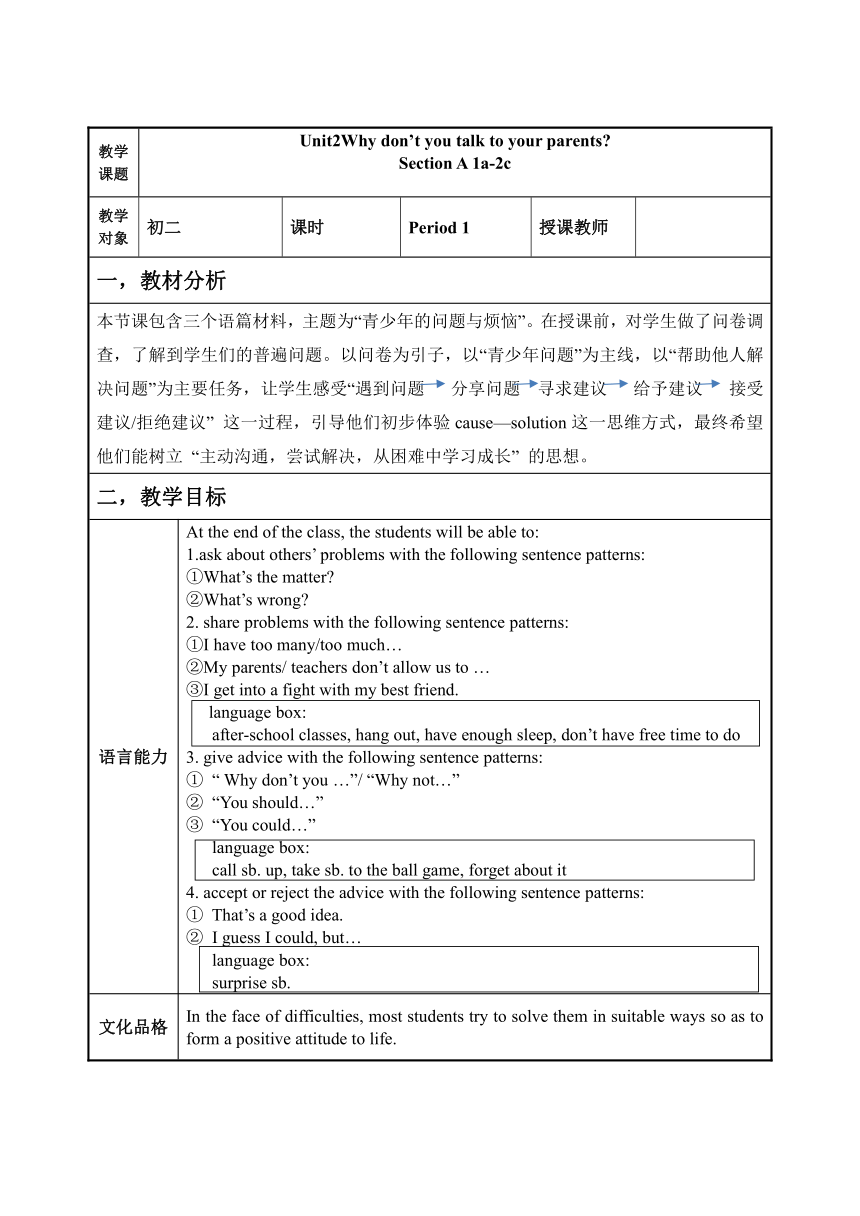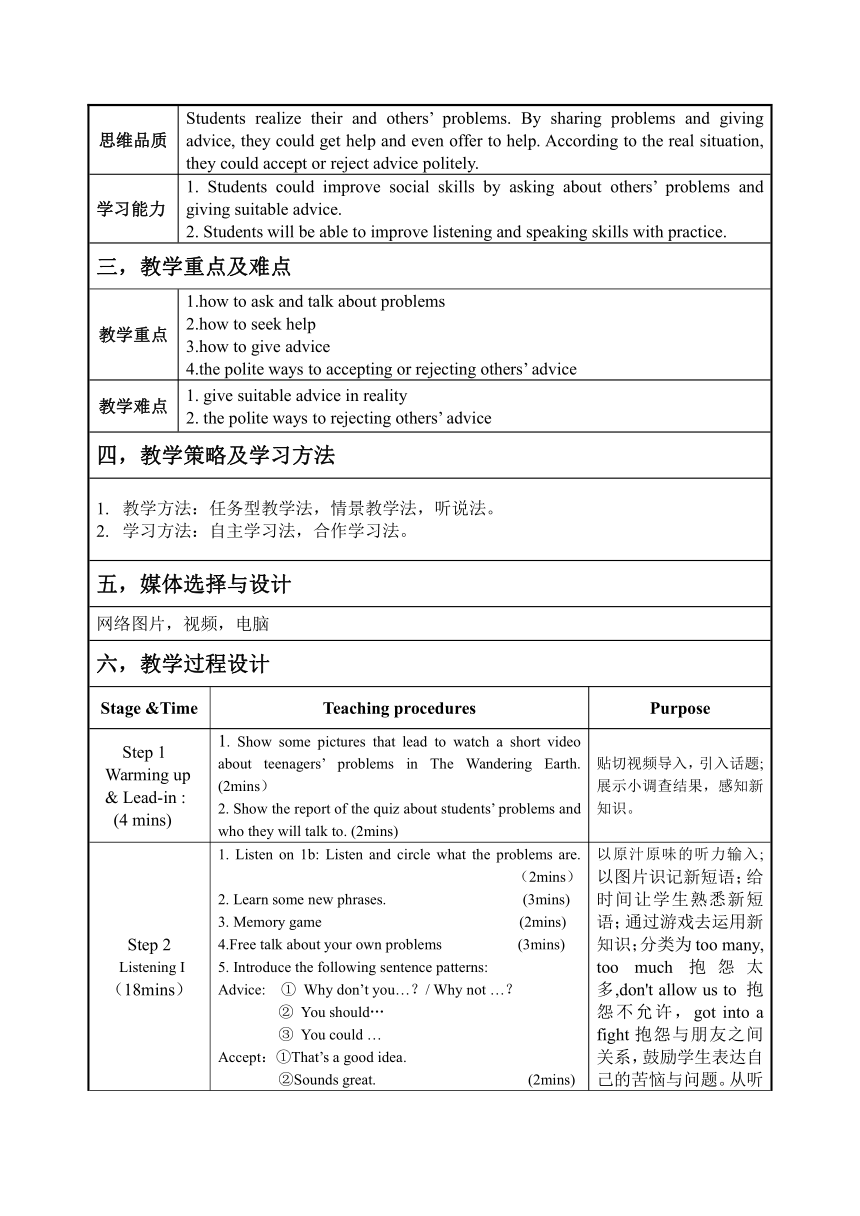鲁教(五四)版八年级上册Unit 2 Why don't you talk to your parents? Section A 教案(表格式)
文档属性
| 名称 | 鲁教(五四)版八年级上册Unit 2 Why don't you talk to your parents? Section A 教案(表格式) |  | |
| 格式 | doc | ||
| 文件大小 | 135.5KB | ||
| 资源类型 | 教案 | ||
| 版本资源 | 鲁教版 | ||
| 科目 | 英语 | ||
| 更新时间 | 2022-10-09 08:38:32 | ||
图片预览


文档简介
教学课题 Unit2Why don’t you talk to your parents Section A 1a-2c
教学对象 初二 课时 Period 1 授课教师
一,教材分析
本节课包含三个语篇材料,主题为“青少年的问题与烦恼”。在授课前,对学生做了问卷调查,了解到学生们的普遍问题。以问卷为引子,以“青少年问题”为主线,以“帮助他人解决问题”为主要任务,让学生感受“遇到问题 分享问题 寻求建议 给予建议 接受建议/拒绝建议” 这一过程,引导他们初步体验cause—solution这一思维方式,最终希望他们能树立 “主动沟通,尝试解决,从困难中学习成长” 的思想。
二,教学目标
语言能力 At the end of the class, the students will be able to:1.ask about others’ problems with the following sentence patterns:①What’s the matter ②What’s wrong 2. share problems with the following sentence patterns:①I have too many/too much…②My parents/ teachers don’t allow us to …③I get into a fight with my best friend.language box:after-school classes, hang out, have enough sleep, don’t have free time to do3. give advice with the following sentence patterns:① “ Why don’t you …”/ “Why not…” ② “You should…”③ “You could…” language box: call sb. up, take sb. to the ball game, forget about it4. accept or reject the advice with the following sentence patterns:① That’s a good idea. ② I guess I could, but… language box: surprise sb.
文化品格 In the face of difficulties, most students try to solve them in suitable ways so as to form a positive attitude to life.
思维品质 Students realize their and others’ problems. By sharing problems and giving advice, they could get help and even offer to help. According to the real situation, they could accept or reject advice politely.
学习能力 1. Students could improve social skills by asking about others’ problems and giving suitable advice. 2. Students will be able to improve listening and speaking skills with practice.
三,教学重点及难点
教学重点 1.how to ask and talk about problems2.how to seek help3.how to give advice4.the polite ways to accepting or rejecting others’ advice
教学难点 1. give suitable advice in reality 2. the polite ways to rejecting others’ advice
四,教学策略及学习方法
教学方法:任务型教学法,情景教学法,听说法。学习方法:自主学习法,合作学习法。
五,媒体选择与设计
网络图片,视频,电脑
六,教学过程设计
Stage &Time Teaching procedures Purpose
Step 1Warming up & Lead-in : (4 mins) 1. Show some pictures that lead to watch a short video about teenagers’ problems in The Wandering Earth. (2mins)2. Show the report of the quiz about students’ problems and who they will talk to. (2mins) 贴切视频导入,引入话题;展示小调查结果,感知新知识。
Step 2Listening I(18mins) 1. Listen on 1b: Listen and circle what the problems are. (2mins) 2. Learn some new phrases. (3mins)3. Memory game (2mins)4.Free talk about your own problems (3mins)5. Introduce the following sentence patterns:Advice: ① Why don’t you…?/ Why not …?② You should…③ You could …Accept:①That’s a good idea.②Sounds great. (2mins)6. Practice: ask about problems and give advice. (3mins)7. Task: Be a little helper. Listen to my problems and give your own advice.situations: ①. I don’t have friends.②My teachers don’t allow me to eat in class.③I have too much homework. (3mins) 以原汁原味的听力输入;以图片识记新短语;给时间让学生熟悉新短语;通过游戏去运用新知识;分类为too many, too much抱怨太多,don't allow us to 抱怨不允许,got into a fight抱怨与朋友之间关系,鼓励学生表达自己的苦恼与问题。从听力中挖掘归纳出询问问题,给出建议,接受建议的句型;以图片进行半控制训练;结合生活,设置真实情景,不进行任何控制,让学生提出合适建议;
Step3 Listening II (11mins) Work on 2a Listen and fill in the blanks with “could” or “should”. Key points: Stronger words have more stars: Why don’t you…?Why not …?*** You should…** You could…* (2mins) Work on 2bListen again and find out why doesn’t he like his friend’s idea Write the letters (a-e) next to the advice in 2a. (2mins)Key points: The polite ways to reject others’ advice: We’d better thank for others’ advice and give our reasons.I don’t think so, although it’s a good idea. I know I should, but it’s not easy.I guess I could, but I don’t want to … (2mins)3. Task: Practice about how to reject others politely with the pictures. (5mins) 听力导入用 “should” “could”给建议的情况; 归纳出语气程度,从高到低分别为 “Why don’t…”“Why not…”到“should”再到“could”;听力输入真实语境中,会有拒绝对方建议的情况。挖掘归纳礼貌谢绝对方的句型;结合图片进行半控制训练。
Step4Consolidation (9mins) Group work:Rule :Choose one problem and ask your classmates for advice. Decide which advice is the best. Work in group of four, one talks about problems. Other three students try to give an advice for him/her. Say no to some advice and say yes to the last advice. Situations: My parents care more about my little sister or brother. My teachers give me too much pressure. My best friend has a new friend.Show a sample for students if they need. 输出活动,设置三个来自学生的真实问题情境,向同学询求最佳建议,要求否定部分建议,同意最后一个建议,有个好的结局。培养学生在日常真实生活中提出适当建议,并礼貌接受或拒绝建议。
Step5 Summary (2mins) the ways to asking about problems;the ways to giving advice;the polite answers to accept or reject others’ advice;Share a saying: Talking to others is very helpful. Let’s try to solve the problems and relax ourselves. 学生小结本节课所学知识;进行德育渗透,帮助学生认识到生活中的一些困难,能用正确的方式解决,主动与他人沟通,寻求帮助,逐步建立起积极的生活态度。
七,板书设计
Unit4 Why don’t you talk to your parents Section A 1a-2cProblems: too many/too much ask advice accept/ reject Why don’t you do sth That’s a great idea.get into a fight don’t allow …to What’s the matter Why not do sth? You should… I guess I could, but… You could…
Try to solve them
教学对象 初二 课时 Period 1 授课教师
一,教材分析
本节课包含三个语篇材料,主题为“青少年的问题与烦恼”。在授课前,对学生做了问卷调查,了解到学生们的普遍问题。以问卷为引子,以“青少年问题”为主线,以“帮助他人解决问题”为主要任务,让学生感受“遇到问题 分享问题 寻求建议 给予建议 接受建议/拒绝建议” 这一过程,引导他们初步体验cause—solution这一思维方式,最终希望他们能树立 “主动沟通,尝试解决,从困难中学习成长” 的思想。
二,教学目标
语言能力 At the end of the class, the students will be able to:1.ask about others’ problems with the following sentence patterns:①What’s the matter ②What’s wrong 2. share problems with the following sentence patterns:①I have too many/too much…②My parents/ teachers don’t allow us to …③I get into a fight with my best friend.language box:after-school classes, hang out, have enough sleep, don’t have free time to do3. give advice with the following sentence patterns:① “ Why don’t you …”/ “Why not…” ② “You should…”③ “You could…” language box: call sb. up, take sb. to the ball game, forget about it4. accept or reject the advice with the following sentence patterns:① That’s a good idea. ② I guess I could, but… language box: surprise sb.
文化品格 In the face of difficulties, most students try to solve them in suitable ways so as to form a positive attitude to life.
思维品质 Students realize their and others’ problems. By sharing problems and giving advice, they could get help and even offer to help. According to the real situation, they could accept or reject advice politely.
学习能力 1. Students could improve social skills by asking about others’ problems and giving suitable advice. 2. Students will be able to improve listening and speaking skills with practice.
三,教学重点及难点
教学重点 1.how to ask and talk about problems2.how to seek help3.how to give advice4.the polite ways to accepting or rejecting others’ advice
教学难点 1. give suitable advice in reality 2. the polite ways to rejecting others’ advice
四,教学策略及学习方法
教学方法:任务型教学法,情景教学法,听说法。学习方法:自主学习法,合作学习法。
五,媒体选择与设计
网络图片,视频,电脑
六,教学过程设计
Stage &Time Teaching procedures Purpose
Step 1Warming up & Lead-in : (4 mins) 1. Show some pictures that lead to watch a short video about teenagers’ problems in The Wandering Earth. (2mins)2. Show the report of the quiz about students’ problems and who they will talk to. (2mins) 贴切视频导入,引入话题;展示小调查结果,感知新知识。
Step 2Listening I(18mins) 1. Listen on 1b: Listen and circle what the problems are. (2mins) 2. Learn some new phrases. (3mins)3. Memory game (2mins)4.Free talk about your own problems (3mins)5. Introduce the following sentence patterns:Advice: ① Why don’t you…?/ Why not …?② You should…③ You could …Accept:①That’s a good idea.②Sounds great. (2mins)6. Practice: ask about problems and give advice. (3mins)7. Task: Be a little helper. Listen to my problems and give your own advice.situations: ①. I don’t have friends.②My teachers don’t allow me to eat in class.③I have too much homework. (3mins) 以原汁原味的听力输入;以图片识记新短语;给时间让学生熟悉新短语;通过游戏去运用新知识;分类为too many, too much抱怨太多,don't allow us to 抱怨不允许,got into a fight抱怨与朋友之间关系,鼓励学生表达自己的苦恼与问题。从听力中挖掘归纳出询问问题,给出建议,接受建议的句型;以图片进行半控制训练;结合生活,设置真实情景,不进行任何控制,让学生提出合适建议;
Step3 Listening II (11mins) Work on 2a Listen and fill in the blanks with “could” or “should”. Key points: Stronger words have more stars: Why don’t you…?Why not …?*** You should…** You could…* (2mins) Work on 2bListen again and find out why doesn’t he like his friend’s idea Write the letters (a-e) next to the advice in 2a. (2mins)Key points: The polite ways to reject others’ advice: We’d better thank for others’ advice and give our reasons.I don’t think so, although it’s a good idea. I know I should, but it’s not easy.I guess I could, but I don’t want to … (2mins)3. Task: Practice about how to reject others politely with the pictures. (5mins) 听力导入用 “should” “could”给建议的情况; 归纳出语气程度,从高到低分别为 “Why don’t…”“Why not…”到“should”再到“could”;听力输入真实语境中,会有拒绝对方建议的情况。挖掘归纳礼貌谢绝对方的句型;结合图片进行半控制训练。
Step4Consolidation (9mins) Group work:Rule :Choose one problem and ask your classmates for advice. Decide which advice is the best. Work in group of four, one talks about problems. Other three students try to give an advice for him/her. Say no to some advice and say yes to the last advice. Situations: My parents care more about my little sister or brother. My teachers give me too much pressure. My best friend has a new friend.Show a sample for students if they need. 输出活动,设置三个来自学生的真实问题情境,向同学询求最佳建议,要求否定部分建议,同意最后一个建议,有个好的结局。培养学生在日常真实生活中提出适当建议,并礼貌接受或拒绝建议。
Step5 Summary (2mins) the ways to asking about problems;the ways to giving advice;the polite answers to accept or reject others’ advice;Share a saying: Talking to others is very helpful. Let’s try to solve the problems and relax ourselves. 学生小结本节课所学知识;进行德育渗透,帮助学生认识到生活中的一些困难,能用正确的方式解决,主动与他人沟通,寻求帮助,逐步建立起积极的生活态度。
七,板书设计
Unit4 Why don’t you talk to your parents Section A 1a-2cProblems: too many/too much ask advice accept/ reject Why don’t you do sth That’s a great idea.get into a fight don’t allow …to What’s the matter Why not do sth? You should… I guess I could, but… You could…
Try to solve them
同课章节目录
- Unit 1 Could you please clean your room?
- Section A
- Section B
- Unit 2 Why don't you talk to your parents?
- Section A
- Section B
- Unit 3 What were you doing when the rainstorm came
- Section A
- Section B
- Unit 4 An old man tried to move the mountains.
- Section A
- Section B
- Unit 5 What's the highest mountain in the world?
- Section A
- Section B
- Unit 6 Have you read Treasure Island yet?
- Section A
- Section B
- Unit 7 Have you ever been to a museum?
- Section A
- Section B
- Unit 8 I've had this bike for three years.
- Section A
- Section B
